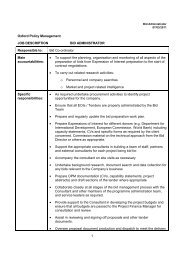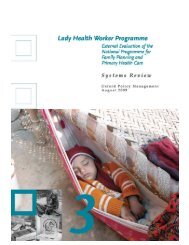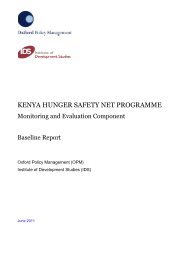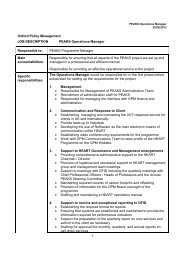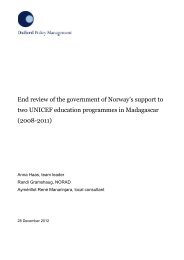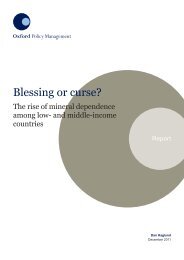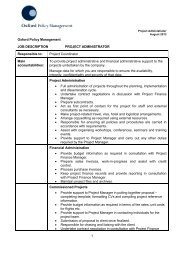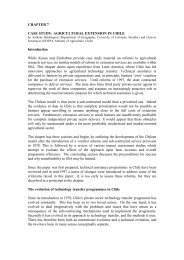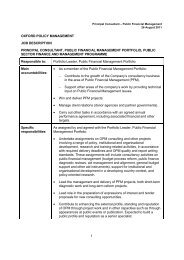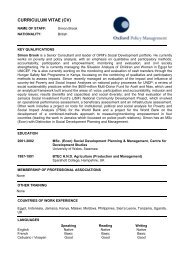LHW Management Review - Oxford Policy Management
LHW Management Review - Oxford Policy Management
LHW Management Review - Oxford Policy Management
You also want an ePaper? Increase the reach of your titles
YUMPU automatically turns print PDFs into web optimized ePapers that Google loves.
List of tables and figures<br />
Table 4.1 Strategic Plan activities for supporting delegation of decision-making .......... 18<br />
Table 5.1 Response by the Programme to issues requiring innovation or quality<br />
improvement identified in the Strategic Plan and PC-1 ................................. 22<br />
Table 5.2 Plan for managing the development of the scope and mix of services<br />
provided by the <strong>LHW</strong> ..................................................................................... 24<br />
Table 5.3 Development of refresher trainings, 2004–08 ............................................... 26<br />
Table 5.4 Type of refresher training received by <strong>LHW</strong> in the previous year, by<br />
province/region .............................................................................................. 27<br />
Table 7.1 Examples of key development partners contributing to primary health<br />
care outcomes ............................................................................................... 38<br />
Table 8.1 Number of health facilities with <strong>LHW</strong>s, by province/region, by year .............. 47<br />
Table 9.1 End of financial year status of <strong>LHW</strong>s working for the Programme ................ 51<br />
Table 9.2 Comparison of the percentage of LHSs covering this number of health<br />
facilities between 2000 and 2008 .................................................................. 53<br />
Table 10.1 Levels of service provision by performance score quartile for services<br />
included in the performance score ................................................................ 58<br />
Table B.1 Functions of the implementation units ........................................................... 71<br />
Table C.1 Decision-making within the Programme ........................................................ 73<br />
Table D.1 Examples of planned linkages between the MNCH programme and<br />
other programmes ......................................................................................... 75<br />
Table E.1 Training conducted for pilot initiatives, 2003–08 ........................................... 77<br />
Table F.1 Allocations of <strong>LHW</strong>s by province/area, 2002–08 ........................................... 79<br />
Table F.2 Comparison of the allocation of <strong>LHW</strong> posts by province/area, 2003–04,<br />
with rural population predictions .................................................................... 79<br />
Table G.1 <strong>Management</strong> change at the FPIU of the <strong>LHW</strong>P, 2001–09 ............................ 81<br />
Table G.2 <strong>Management</strong> changes at the FPIU, <strong>LHW</strong>P, 2001–09 (cont’d) ...................... 83<br />
Table G.3 Changes in Health <strong>Management</strong> at MoH, 2002–09 ...................................... 84<br />
Figure 2.1 The <strong>LHW</strong> through her outreach services ......................................................... 3<br />
Figure 6.1 Organizational structure of <strong>LHW</strong>P and linkages with health system at<br />
different levels of government (federal, provincial, and district) .................... 29<br />
Figure 6.2 Organisation chart of the DPIU...................................................................... 30<br />
Figure 7.1 List of health programmes located in the federal MoH .................................. 35<br />
Figure 7.2 Contribution by <strong>LHW</strong> to other primary health care/public health<br />
programmes and family planning .................................................................. 36<br />
Figure 8.1 The number of working <strong>LHW</strong>s at the end of the financial year<br />
compared with the allocated posts ................................................................ 44<br />
Figure 8.2 Allocation of <strong>LHW</strong> positions in PC-1 (2003–08), by province/ region,<br />
compared with the distribution of the rural population ................................... 45<br />
Figure 8.3 Difference between the recorded allocation of <strong>LHW</strong> posts, by district, in<br />
the PSP database (June 2008) and the districts’ report of their<br />
allocation of <strong>LHW</strong> posts ................................................................................. 46<br />
Figure 8.4 Number of urban <strong>LHW</strong>s, predicted and actual, 2008, by<br />
province/region .............................................................................................. 49<br />
Figure 9.1 Percentage of districts where the Programme expanded between<br />
2003–08 ........................................................................................................ 52<br />
Figure 9.2 Number of <strong>LHW</strong>s working in June each year, and the ratio of LHSs to<br />
<strong>LHW</strong>s ............................................................................................................. 53<br />
xv<br />
xvxv



